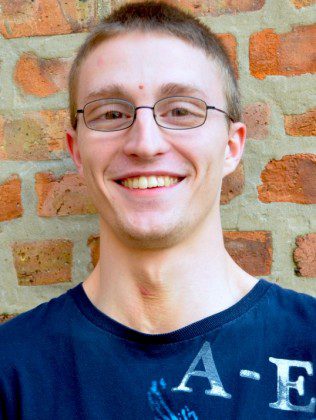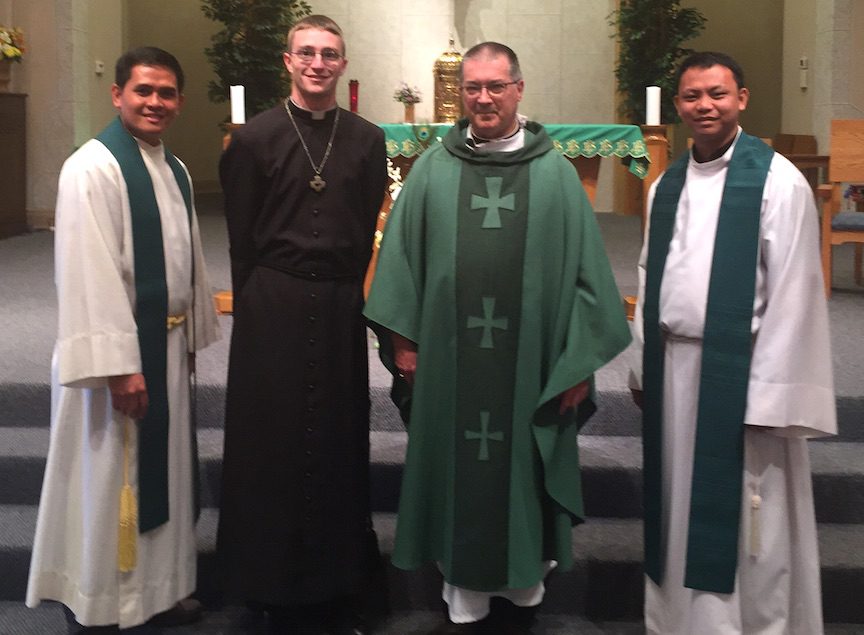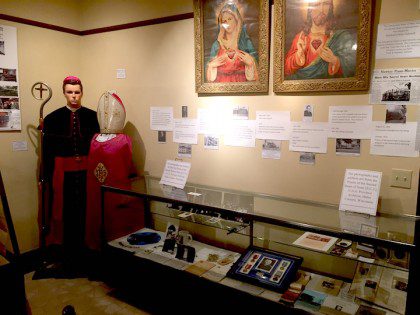
Reflecting on Ste. Marie
In conjunction with Ste. Marie’s annual “Cork and Pork” festival, the Ste. Marie Foundation opened “Amazing Grace: 1837 to Now,” a historical look at the role of churches in the small Illinois town. Fr. Wayne Jenkins, province archivist, helped to develop one of the displays. It features the SCJs’ presence in Ste. Marie, which included a novitiate that served the US and Canada until 1972. Among the items on loan from the US Province are vestments from Bishop Joseph Potocnak and Bishop Joseph DePalma, both of whom spent time in Ste. Marie.
Fr. Wayne, along with Frater Justin Krenke, Fr. Patrick Gutib and Fr. Joseph Butlig, traveled to Ste. Marie for the July 25 opening. Frs. Patrick and Joseph are Philippine SCJs who are in the US Province this summer to study ESL, as well as archival management with Fr. Wayne. Frater Justin is in the midst of a summer ministry assignment in the archives.
Frater Justin and Fr. Patrick wrote reflections on the visit. The first is from Frater Justin:
Bringing stories of “the old days” to life

As a young SCJ in formation there are a few things you have to get used to, such as living with 12 other men, having a roommate, and sharing the responsibilities of cleaning and sharing cars. Those are the sorts of things that you tell yourself to prepare for before you enter. But there is one thing that I never expected to get ready for: a regular retelling of the stories of “the old days.”
At table one hears “at Donaldson we used to…” or “when we had the minor seminaries…” and once you enter the novitiate you ALWAYS hear “When I was in the novitiate at Ste. Marie…”
While these stories can be funny, and they give a sense of how the formation process has changed, for those of us who haven’t been to Donaldson, Kilroe, or Ste. Marie, they are stories to which we have little connection. We know some of the people in the stories, but that’s about it. Most of us in formation now have never been to or even seen pictures of these places we’ve heard about. So when we are told these stories we only understand about half of them, not out of disinterest but because we cannot connect them to any mental image or memory of a minor seminary or the old novitiate in Sainte Marie.
When I started my summer ministry experience in the archives the first thing that Fr. Wayne asked me was “What do you want to take away from working in the archives this summer?”
My answer? “I want to know more about the minor seminaries.”
I wanted to at least see pictures and perhaps learn what has happened to some of the places the SCJs used to have and were so much a part of the lives my older community members. But I never thought that I would actually be able to go to visit one of these places.
The weekend of the July 25 Fr. Wayne took Fr. Joseph and Fr. Patrick, our confreres from the Philippines, and me to the town of Ste. Marie to attend their Cork and Pork festival where the Ste. Marie Foundation would be opening their new year-long exhibit named “Amazing Grace.”
In the exhibit the foundation talks about the role the church has played in the life of Ste Marie. They had artifacts from the first church in the town, which was struck by lighting and burnt to the ground where the present church of St. Mary of the Assumption now stands. They showed the religious habits of all the different orders of nuns that worked in the town throughout the years.
The reason we were there is that the foundation asked Fr. Wayne for his help in setting up a section dedicated to the Priests of the Sacred Heart and the old novitiate, or Mission House, as they still call it.
During our visit we stayed in the rectory of St. Mary of the Assumption church where many of our confreres took their first vows, including Fr. Wayne, who celebrated Mass on Saturday and Sunday during our stay. On Saturday we walked over to the Sainte Marie Foundation House where the exhibit was and were shown all the different things that people donated for it.
The exhibit was very interesting but the best part was talking to some of the people who live in the town. Many were older so they remember well when the SCJ novices were in Ste. Marie and some of the guys who worked there. Even some of the younger people in the town still call it the Mission House even though our community left over 40 years ago.
On Sunday after Mass we were given a tour of the old novitiate. The building currently is used for special education so it has been kept up and had some renovations. When you first walk into the building you see old pictures of it and of what the chapel used to look like. There were other reminders of the building’s previous life as a school, such as the walk-in freezers in the basement. The farm is still there, but the pool did not survive.
Being able to go to Ste. Marie to see the town, walk through the old novitiate building and hear stories from the people who lived there was an experience I’m very glad to have had. It gave me a better understanding of all the stories I’ve heard.
I also learned why they called it “Steam Marie,” (it was hot and humid!) and I finally have a personal connection to a place that was just an unknown piece of history when an SCJ would start another story with “When I went to Ste. Marie…”

“Some day we will be collecting items to preserve the history of the Philippine Region”
Fr. Patrick, as a part of his ESL studies, wrote the following reflection on his weekend in Ste. Marie:
Significant events that happen in one’s life are worthy of reminiscing. Those memories can be remembered through places, objects, and personal encounters. Ste. Marie is a great example of that. Ste. Marie, where the first novitiate house of the US Province was located, holds important memories for the SCJs who did their formation from the 1920s to the 1970s. Thus, it is worth visiting the place to see and reflect how the province has changed since those times. I was fortunate to have visited this place recently. During our visit, three things interested me in particular: the place, the community, and the old SCJ novitiate house itself.
I believe that it was not only the daily novitiate activities that impacted the lives of the men in formation, but the beauty and tranquility of the place as well. As we drove from Decatur to Ste. Marie, I was amazed by the vastness of land. The corn and soybean fields seemed like an ocean that runs on and on.
I rarely saw houses in the middle of the fields, unlike in the Philippines. I wondered how the people transported their products, or if there was any train in the area. I tried to imagine how the seminarians spent their days farming and raising livestock for their food. It must have been tough work. I also wondered how they spent their recreation or day off. Indeed, Ste. Marie has typical countryside ambience, which is quiet and calm. It manifests a simple way of life. Its tranquility is apt for a novitiate – a good place to be silent and alone with God.

I also enjoyed the people. I appreciated very much how they work hard to keep their community united. During the Mass on Saturday evening I was surprised by the large number of people who came to church. It was full; I was not expecting such attendance. This is the oldest parish in the diocese. Moreover, the people were accommodating and hospitable. They were approachable, so it was easy to talk to them. Some of them even shared stories about SCJs they knew. Their hospitality allowed us to stay in the rectory.
Besides taking care of their faith, the people in Ste. Marie also take care of their history. They have a foundation called the “Ste. Marie Foundation,” which I was also able to visit. It is a house that was made into a small museum. In that house are many artifacts given by the residents of Ste. Marie since its founding by the Picquet family back in 1830. There were also historical items from different religious communities who have lived in the area, including the Priests of the Sacred Heart. Having visited this little museum, I felt enriched by the artifacts and the history.
I thought about how someday we will be collecting important items and documents to preserve the history of the SCJs’ Philippine Region. Thus, I greatly admire their community for their will to preserve their own history.
The old novitiate house added a significant experience to the visit. The building is now an office for special education. The right wing of the building burned down in the 1970s; soon after, the novitiate program moved to another city.
When I entered, I saw some of the parts that remained the same, like the laundry area, the library and the wooden refrigerators, but they are not used anymore. The bigger rooms were already converted into small offices, others into stockrooms. Nonetheless, being in that building gave me a glimpse of what formation used to be like here. Certainly, the Ste. Marie novitiate is precious, especially to those who were a part of it. Yet, it is not just the house that holds memories but the entire compound, from the yard to the barn where seminarians once labored for their food. This house had borne religious men who must be grateful for having been formed in such an environment.
I realized then that there may be a time in the Philippines when our current formation houses close or move; how things can change anywhere.
I had a wonderful visit to Ste. Marie. The place, the people and the old novitiate house have enriched my visit to the United States. The experience has enlivened as well my hope for the SCJ Philippine Region as we progress in our ministry. For now, we have a few memorable and significant events that have to be treasured, yet we will have more as we continue to grow and actualize our vision. Then one day we will also long to visit those places and people again.
A Memorable Visit to Ste. Marie
Fr. Joseph shares his thoughts on the visit to Ste. Marie:
I have been visiting many places since I arrived last June 2015, in the United States. I asked myself which one of those visits has most impacted my life? I cannot deny the fact that Chicago, Milwaukee, Springfield, Newton and other sites that I visited have made a good impression on me. However, Ste. Marie was a one-of-a-kind experience for me. It was a place abundant in corn and bean farming. The Catholic faith of the people was very much alive. It was where the first SCJ novitiate formation house of the American Province was and some of the SCJ’s assisted the parishes and religious communities in the area. Indeed, the visit I had at Ste. Marie was a memorable one.
One Friday morning, I woke up at 6 AM, took a bath, and then went to St. Joseph Chapel for a Mass with my companions on the journey to Ste. Marie. After we ate our breakfast, we left the seminary to start the trip. As we approached the town of Ste. Marie I saw a very huge farm of corn and beans. Almost three-fourths of the land area was corn and bean fields. The vastness of the farm got my attention. I was really amazed because it was the first time I saw a farm that large. Never in my whole life have I seen a farm that extensive. As I continued to observe the view of the farm I came up with an insight that people living around the area were really hardworking and industrious, and I was right. As soon as we arrived at Ste. Marie we stopped in front of the Ste. Marie Foundation House. It was a place where exhibits of artifacts were displayed, and one of the exhibits showed that since the 18th century corn and bean farming were the main livelihood of the people, and this is still true today. We spent only a couple of minutes in the foundation house before going to the convent to rest and sleep before continuing our itinerary.
It was a sunny Saturday morning when I woke up at around 8:00 AM, took a bath, and ate my breakfast. Right after I had my morning meal, I walked towards the Church that was a walking distance from the convent where we slept. I entered and I was really amazed by the interior design, simple yet perfect for prayer. I had a positive impression that the church was very well maintained by the Catholic people of the place despite the absence of a residential pastor. Then, I went back to the convent and waited until afternoon for the anticipated Mass scheduled that day. Time came for the afternoon Mass and I was surprised because the priest in charge allowed me to concelebrate with him. As soon as the Eucharistic celebration began, I was very amazed by the number of the faithful who attended the celebration; the Church was almost fully packed. Not only that, I saw good number of kids, teenagers, and young professionals, in addition to the older people. I had heard that this was unusual in the Catholic setting in the United States. As I mingled and talked to the people after the Mass, I found out that the majority of the people around the area were devoted Catholics who always spared time for Church. Aside from that, the parents always encourage the participation of their children. After I learned all this information, I was deeply inspired by their expression of faith and told myself as I went back to the convent that I have to do the same in my service to God.
The last day of my stay in Ste. Marie came and started with a Sunday Eucharistic morning celebration. This time I expected that the same parishioners would be present in the celebration, but I was wrong. The faithful who attended the celebration were not the same, but fewer in number compared to the anticipated Mass we had the night before. After the Eucharistic celebration, I went back to visit the foundation house of Ste. Marie. As I explored the exhibits I saw some of the artifacts from our SCJs who have worked at Ste. Marie. It was a privilege for me to know the history of how the SCJs influenced the growth of faith in the people of Ste. Marie and that it continues alive and strong today. I appreciated the great work done by the SCJ missionaries during those days and I was inspired to do the same. I have learned a lot from the exhibits and came up with an insight that I can do the same thing in the Philippines, particularly in arranging the artifacts. The time came when I had to leave with my companions to visit the first SCJ novitiate house of the American Province. As soon as we arrived at the place we had a tour. I had a good impression of the institute that took over the property because they maximize the use of all the facilities. They made some renovations so that all the facilities that had been designed for a seminary setting were converted into a facility for special students. The tour was fun and very informative, and gave me an idea about the life of the SCJ novices who became part of the program at that time and the function of the facilities at present.
Indeed, my visit to Ste. Marie was a memorable one because I have learned about the livelihood and faith of the people. I had the privilege of visiting the first American SCJ novitiate and learn about the SCJ missionaries who worked in the area of Ste. Marie. It was a one of a kind of experience that was very informative and enriching for the strengthening of my vocation.
48 years later, SCJ celebrates Mass at church of 1st profession
As noted above, Fr. Wayne Jenkins, province archivist, went to Ste. Marie, Il., the weekend of July 25 to attend the Ste. Marie Foundation’s opening of “Amazing Grace: 1837 – Now.” While there he was invited by the foundation to celebrate Mass at St. Mary of the Assumption Church. It was the same church that he and the rest of his class of 32 SCJs from the US and Canada professed their first vows in 1967.
This was Fr. Wayne’s first time celebrating Mass in the church. Click here to read his homily.

